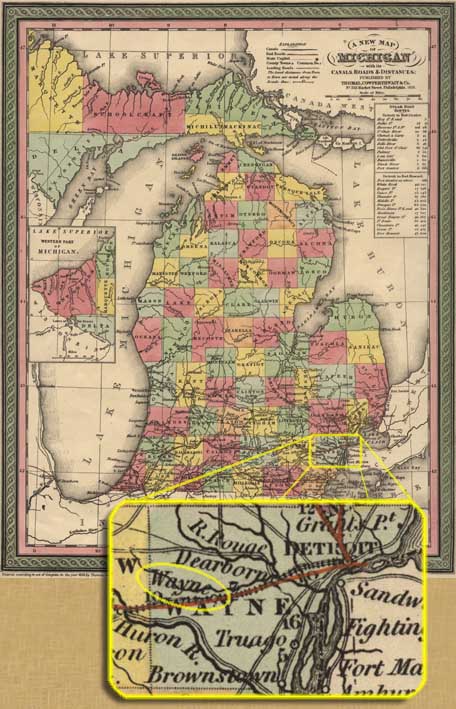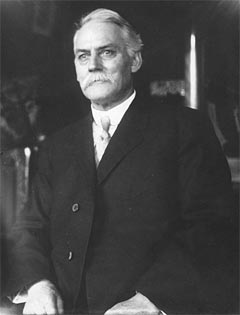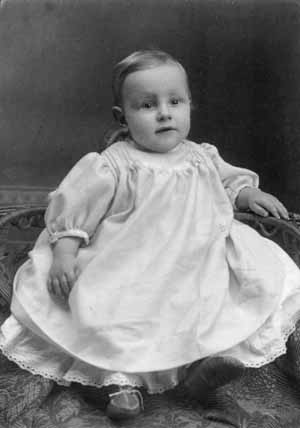

Prologue: Westward Migration
Both the Wrights and the Scattergoods had lived in the area for 150 years or more by the time William was born. But the country was expanding westward now. During the 1830s it was Michigan that was growing faster than any other state or territory. In fact, Michigan had become a state in 1837, just a few years before William's birth. The attraction of the frontier was undoubtedly being felt by all.
A year later, William's father remarried. Over the ensuing three years, another daughter and son joined the family. The early 1860s brought tragedy for the entire country, and the Wright family was not exempt. At least two of William's older brothers fought for the Union in the Civil War. One fell sick, then deserted. Another was wounded, but remained in the army for most of the war.
By 1871, W.P. was in Louisville, Kentucky, where he married Angeline (Angie) Hawkins September 27, and where they made their first home. Angie's father had emigrated from England. Her mother died when she was young, her father remarried, and she and her sister Mary were raised by their maternal grandmother, Sarah May. According to family lore, Sarah herself had been in Scott County, Indiana, September 3, 1812.
These were exciting days for the Chicago, Milwaukee and St. Paul. It was operating on 3,775 miles of track, owned 425 locomotives, over 300 passenger coaches and 13,315 freight cars. Net earnings were in excess of $5.3 million (nearly $100 million in year 2001 dollars). By early 1881, its tracks extended as far west as the Missouri River at Chamberlain, South Dakota. An extension of the line to the Pacific Coast was begun in 1906 and completed to Seattle by 1909. W.P. Wright worked for the CM&SP until he passed away in 1912. After the move to Chicago, four more children were born: Richard Hawkins (December 1880), (Sarah) May (May 1884), Thomas (January 1886), and Persis Helen (June 1890). Two things are passed down in family lore about W.P. One, he earned a reputation as “the human adding machine” for his The other, he was a strict and harsh disciplinarian—so harsh, in fact, that Clay Lloyd, about ten years old and facing discipline when his father returned home from work, chose to run away instead and was never heard from again. As a young man, W.P.'s son John worked various jobs in the Chicago area. At some point, he got a job on a railroad construction crew, doing bridge maintenance. (Perhaps it was in the course of this employment that he developed his love of handling teams of horses.) It was apparently this job that took him to South Dakota. The Dakotas had only recently become states, in 1889. The last war with the Native Americans in the area had ended in 1877, in the wake of the demise, the previous year, of the Seventh Cavalry under George Custer. The “Great Dakota Boom” had followed with its huge influx of settlers. But recent weather had not been kind. The years 1886 and 1887 had brought a severe drought that caused many to leave. Exactly when John came to South Dakota isn't known. But two significant events in his life occurred there, though which occurred first is not clear. One was the Spanish-American War. The other was meeting a young woman. When the embers of the Spanish-American conflict were fanned into flame by William Randolph Hearst's journalists, Troops from North Dakota, South Dakota, Montana, and Nebraska formed a unit that became the 3rd U.S. Volunteer Cavalry. The 3rd was mustered into the federal service in May 1898, but never left the country and appears to have spent the majority of its brief career at Camp Thomas, Georgia. With the armistice of August 13, the 3rd Cavalry was no longer needed, and was mustered out at Camp Thomas on September 8, 1898. In Aurora County, South Dakota, near White Lake, John met, and was attracted to Minnie, oldest daughter of Evert and Willemina Hulshof. The Hulshofs had immigrated from Holland in 1880 and settled first in Sioux Center, Iowa, then in Douglas County, South Dakota where there was a significant Dutch population. Evert was determined that his children grow up as Americans and not Dutch, however, so chose to leave the Dutch enclave for White Lake. In addition to Minnie (Willemina Aleida), their children were Gerrit Willem, Evert Jan (who died soon after his first birthday), Diena, and Anna.
After meeting Minnie, John decided to remain near the Hulshofs, and busied himself in the area. He and Minnie married December 5, 1901. Barely ten months later, October 12, 1902, their first child, son (Robert) Irvine was born. Irvine was named after his father's uncle, (James Callendar) Irvine Wright. The elder Irvine lived near the family “home town” of Bristol, Pennsylvania. Though they never met (as far as is known), the two Irvines developed a that continued until the elder's death about 1926.
During this period, another wedding took place. Minnie's brother Gerrit met John's sister Charlotte (“Lottie”), apparently in connection with the marriage of John and Minnie. They were married February 14, 1906, and farmed near Winner, South Dakota until about 1920. Then they moved west and settled near Albany, Oregon. In fact, by 1925 most of W.P. and Angie Wright's offspring were living on the West Coast—Will in Hoquiam, Washington, Richard in Seattle, and Charlotte Hulshof, Persis McCormack and John in the Albany, Oregon area. Only May Taft and Tom remained in the Midwest. But this is getting ahead of the story… 
|
||||||||||||





